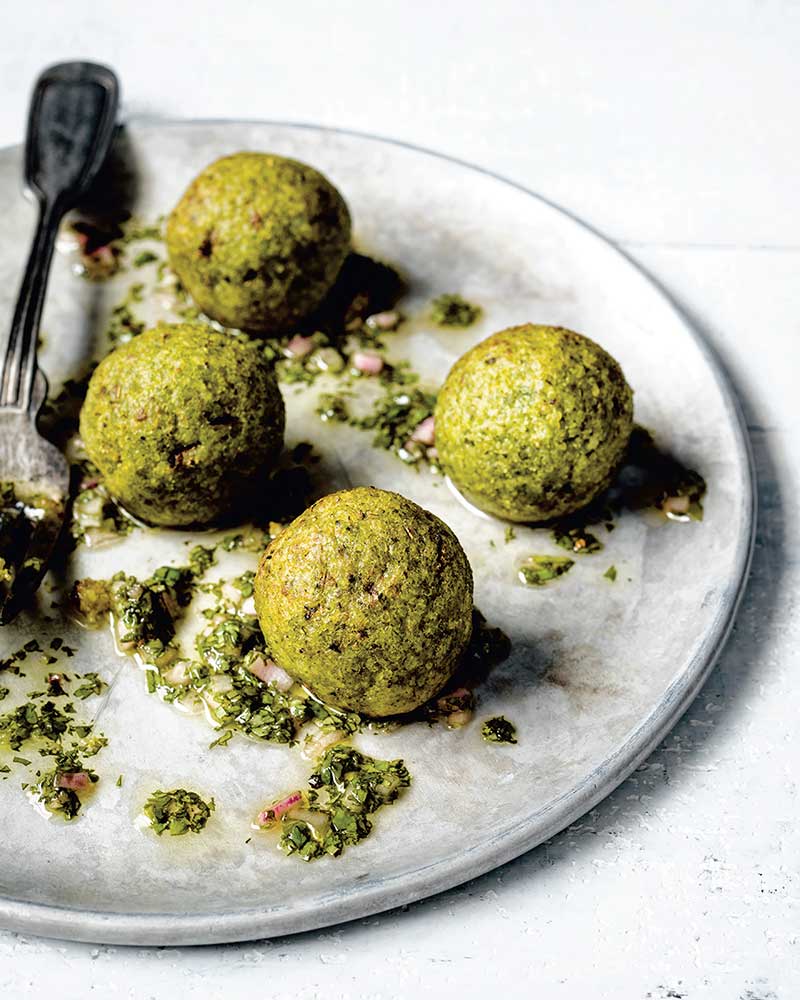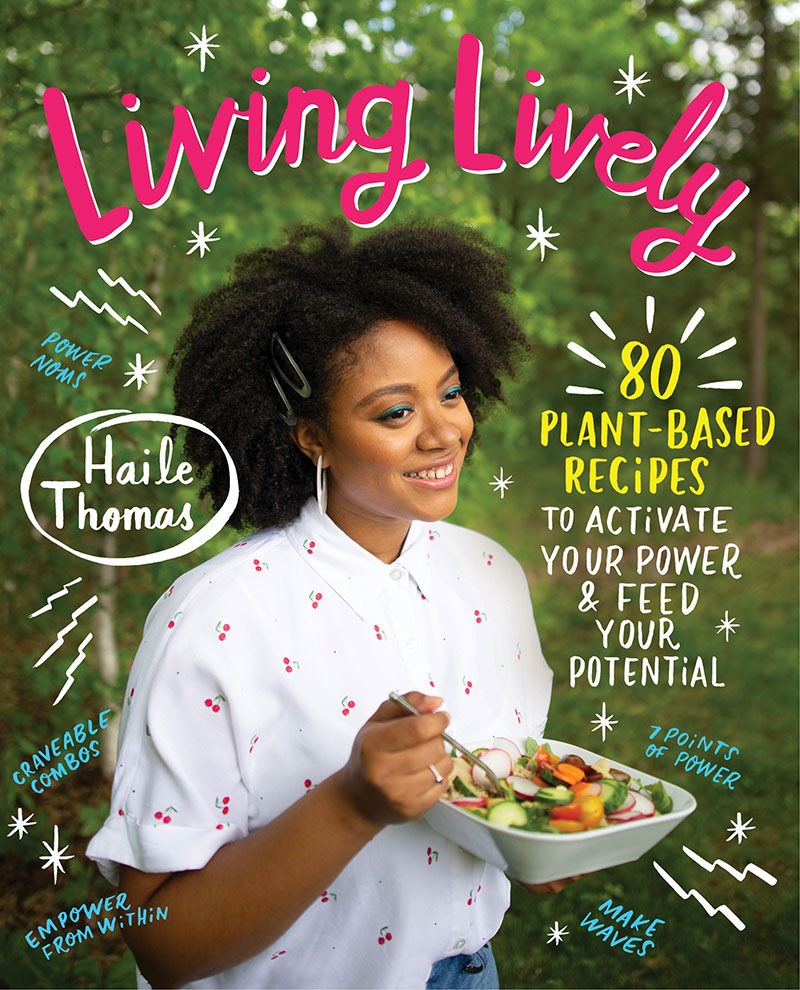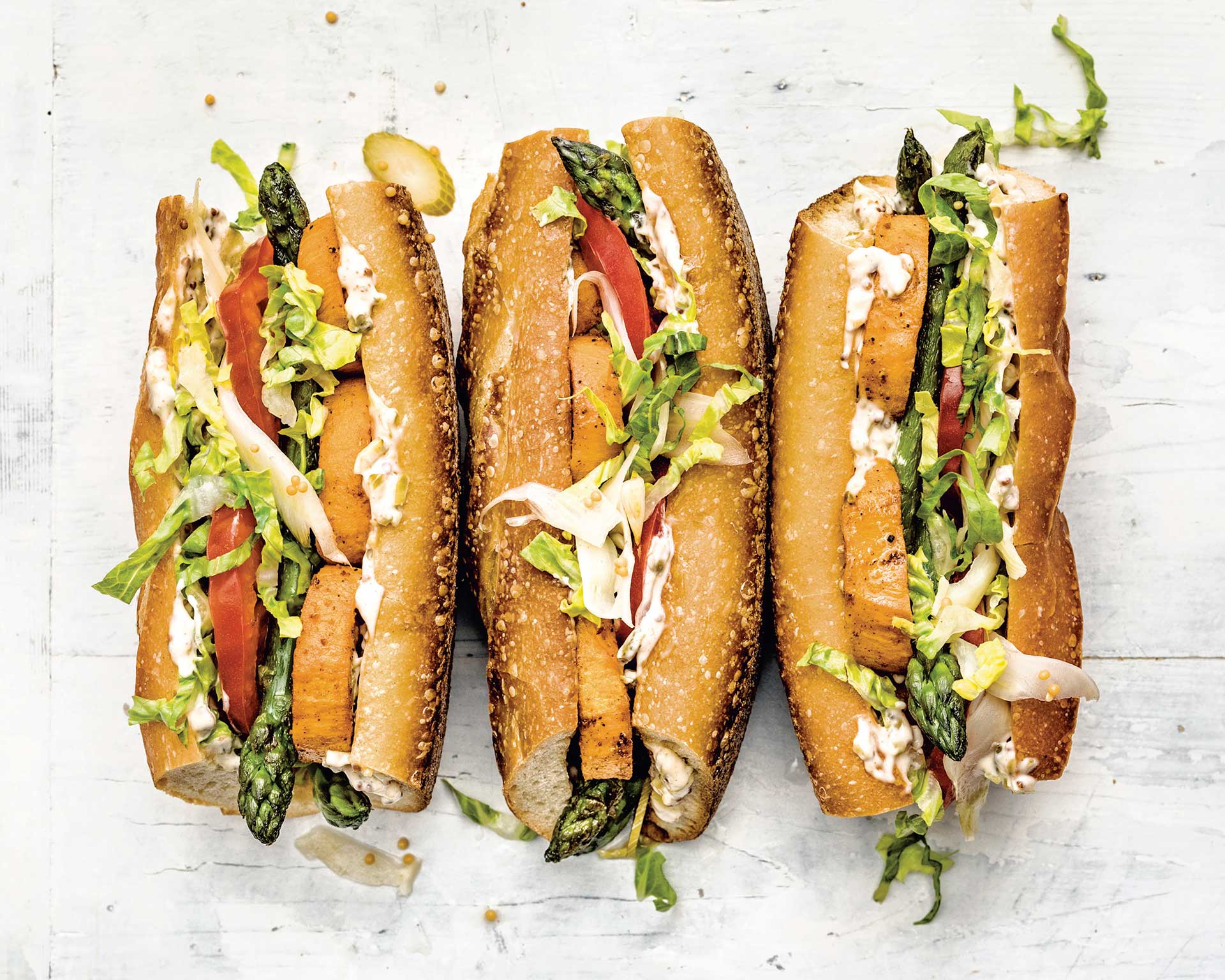Cookbooks That Celebrate Black Vegan Recipes
With a constant stream of plant-based cookbooks, meal kit services and Instagram influencers, the boom in plant-based and vegan diets isn’t going anywhere. Market researchers predict that the global vegan food market will grow from $16.05 billion to $18.27 billion between 2022 and 2023 alone, exceeding $29 billion by 2027. But that market has often ignored one group that has long been a driver in the frequently whitewashed vegan movement: Black vegans.
“Black veganism” isn’t simply a descriptor of Black people cooking and eating vegan food. Instead, the movement has intersectional roots and motivations that are more expansive than just animal welfare, environmentalism and personal health, including anti-racist advocacy, food sovereignty and community health and healing. Recipes can celebrate the mostly plant-based diets of pre-colonial West and Central Africa, as well as the religious customs of groups like the Ethiopian Orthodox Tewahedo Church and the Nation of Islam. “As their identities and communities are threatened across other facets of society,” Khushbu Shah wrote in a 2018 piece on the so-called vegan race wars, for Thrillist, “diet choice has become an important avenue for vegans of color to express, reclaim and protect their identities.”
The roots of the Black vegan movement in the U.S. can be traced back more than a century. Generations of Black humanitarian activists like Coretta Scott King, Rosa Parks and Angela Davis have promoted vegetarian and vegan diets, and Sen. Cory Booker and others have kept plant-based eating in the political conversation. But many of today’s Black vegan leaders come from the world of entertainment and sports. In the music industry, stars like Cardi B, Beyoncé and Jay-Z and most of the Wu-Tang Clan have encouraged vegan lifestyle choices. Black athletes like Venus Williams and weightlifter Kendrick Farris promote the diet’s health advantages.
Thanks perhaps in part to this high-profile support, the Black vegan demographic is growing faster than any other. It’s a movement that’s increasingly reflected in the cookbook section: Recent releases authored by Black vegan chefs and recipe developers include “Black Rican Vegan” by Lyana Blount, “Sweet Potato Soul” by Jenné Claiborne, Emani Corcran’s “Blk + Vegan” and many more.
Neither Bryant Terry nor Haile Thomas market their cookbooks specifically using the “Black vegan” label, but they nonetheless touch on these deep roots and multilayered motivations. Terry, a food activist and founder of 4 Color Books, has widely explored veganism in 2009’s “Vegan Soul Kitchen” and 2014’s “Afro Vegan.” He wrote “Vegetable Kingdom,” published in February 2020, for his daughters: “Educating my girls about and introducing them to food and flavors of the African Diaspora…helps them learn about and take pride in the contributions of their ancestors,” Terry writes in the introduction, “and it celebrates foods of the African Diaspora in a world where European cuisine is at the center and Black food is often at the margins.”

In “Vegetable Kingdom,” Terry showcases plant diversity through the lens of his daughters’ multicultural identity, merging Black culinary techniques with those of his wife’s Asian heritage. Some dishes pay homage to his Memphis upbringing and time spent in New Orleans: vegan soul food recipes like millet roux-mushroom gumbo, dirty cauliflower “rice” and a sweet potato and asparagus po’boy (recipe below). Others, like jollof-inspired rice and coconut curry with panko-crusted cauliflower, honor traditional Central and West African recipes. Skipping meat substitutes, Terry focuses on fresh ingredients, bright spices and sound techniques. He uses heritage grains like teff and fonio (both native to Africa); slathers vegetables with jerk marinades, Creole sauce or blackened seasoning; and uses cooking methods like ash-roasting and pickling to add depth to his food.
Terry includes a playlist in the cookbook — an idea he started with “Vegan Soul Kitchen” — tying his cooking to favorite musicians including Run-DMC, Sarah Vaughan and Dezarie. “The music that moves me and the recipes I create are intrinsically linked,” he writes. “My earliest memories include my maternal grandmother singing in her kitchen…mom crooning while making dinner, and my aunts and uncles harmonizing at family gatherings.”
With “Vegetable Kingdom,” Terry passes along that pride and love of food; his daughters taste-tested all of the book’s 150-plus recipes, learning new flavors and preparations along the way. Terry says these recipes are also a great way for adults to explore vegan flavors while celebrating the cuisine of the African Diaspora: “You may not have tried (or heard of) kohlrabi,” he writes, “but I promise you’ll be hooked once you simply coal-roast it and serve it with West African-inspired peanut sauce.”
For 19-year-old Haile Thomas, author of “Living Lively,” vegan cooking is tied not to early childhood food memories but ones that she and her parents created together as she grew up. The Thomases adopted a plant-based diet after Haile’s father was diagnosed with Type 2 diabetes, deciding to focus on food rather than medicine to treat his disease. After her father recovered, Thomas began speaking about food and nutrition, eventually starting Healthy Active Positive Purposeful Youth (HAPPY), a nonprofit that educates kids about food choices and personal health through after-school programs and camps.

Among her many impressive accolades — she’d given a TEDx talk and spoken with First Lady Michelle Obama by age 10 — Thomas also became the youngest certified Integrative Nutrition Health Coach at age 16. In “Living Lively,” Thomas leans into the health aspects of a vegan diet, but, as the title suggests, also uses it as an entrée into the world of holistic wellness and personal empowerment.
With a neon cover and uplifting tone, Thomas speaks to a younger audience: Sections like “Power Noms” and “Good-Mood Mornings” are packed with classic plant-based recipes like golden milk, quinoa bowls and variations on smoothies and granola. But along the way, she touches on many of the same complex themes of Black veganism.
“On the surface, our relationship with food can be seen as defined by its necessity,” Thomas writes in the introduction — “but the way we perceive nourishing ourselves and our bodies is a product of societal influence, which can be more complicated than simply fulfilling nutritional needs. Sharing stories from five fellow vegans, including environmental activist Hannah Testa, Thomas not only showcases how adopting a plant-based diet can be personally empowering, but also how other Black women she admires relate to veganism.
Thomas also celebrates the foods her Jamaican parents served her growing up: vegan versions of Jamaican cornmeal porridge (made with coconut milk and cinnamon), rice and peas with curry mushrooms and homemade Jamaican jerk sauce. Like Terry, she acknowledges the deep historical roots of her cooking. “Thank you to my ancestors,” Thomas writes in the book’s acknowledgements. “Your persistence and fight to succeed and thrive in the world are the reason I’m here today, and the reason I will continue to ensure that I design a life of meaning, lifting up others along the way.”

Recipe: Roasted Sweet Potato and Asparagus Po’boy
Bryant Terry, “Vegetable Kingdom”
Makes 4 sandwiches
When I lived in New Orleans, ordering a vegetarian po’boy meant you would get bread, mayonnaise, iceberg lettuce, and bland tomatoes. This recipe is the type of sandwich that I wish my crew and I could have eaten back in the day. I started conceiving of this recipe in 2012 when I sandwiched some leftover candied sweet potatoes from my book The Inspired Vegan between bread for lunch. While sweet, the Garnet yams also had a savory essence from the miso, molasses, sesame oil, and tamari in the marinade (in case there is any confusion, while labeled “yams,” Jewel and Garnet yams are actually sweet potatoes). Since most folks can’t imagine a po’boy without some deep-fried element, I was reluctant to share a recipe for one that was stuffed with sweet potatoes. That changed when I ran across a po’boy on the Food & Wine website created by chef Kevin Nashan that included roasted sweet potatoes dusted with Cajun seasoning. I coat mine in blackened seasoning instead, and before roasting, I parboil them.
In culinary school, I learned that this method yields a sweeter, creamier roasted sweet potato. I imagine this sandwich sitting at the crossroads of winter and spring, so I add roasted asparagus to the mix. The dense, sweet-savory Garnet yams and the delicate, earthy asparagus are a perfect match. The piquant Creole rémoulade brings everything together. While this sandwich may not visually read as a po’boy in the way that most people envision them, you best believe it has the spirit of a classic New Orleans “dressed” po’boy.
Ingredients
2 tablespoons plus 3/4 teaspoon kosher salt, plus more as needed
8 ounces asparagus, trimmed and sliced into 3/4-inch pieces
1 pound Garnet yams, peeled and sliced into 1/2-inch-thick rounds
3 tablespoons extra-virgin olive oil
2 teaspoons molasses
2 teaspoons Bragg Liquid Aminos
1 tablespoon Blackened Seasoning
2 (15-inch) loaves soft-crusted French or Italian bread
Creole Rémoulade, for dressing (see recipe below)
2 large heirloom tomatoes, cut into 1/4-inch-thick slices
Freshly ground white pepper
1 cup Dill-Pickled Fennel (see recipe below)
2 cups shredded little gem lettuce
Method
In a large pot, bring 3 quarts water to a boil over high heat. Add 2 tablespoons of the salt and the asparagus. Remove from the heat and let the asparagus sit for 30 seconds. With a spider or tongs, transfer the asparagus to a colander and set aside. Gently slide the yams into the hot water, cover, and set aside for 1 hour. Drain the yams in a colander and set aside to dry for 30 minutes. Transfer to a large bowl.
Preheat the oven to 400°F. Line two baking sheets with parchment paper.
In a small bowl, combine 2 tablespoons of the olive oil, the molasses, liquid aminos, blackened seasoning, and 1/2 teaspoon of the salt and mix well. Pour the mixture over the yams and gently toss to coat. Gently transfer the yams to one of the prepared baking sheets, spread them in an even layer, and roast until tender, about 50 minutes, flipping the rounds once after 25 minutes to ensure even cooking.
In a medium bowl, combine the asparagus with the remaining 1 tablespoon olive oil and 1/4 teaspoon salt. Toss well and transfer to the other prepared baking sheet. After you flip the yams at the halfway mark, place the baking sheet with the asparagus in the oven. Roast for 25 minutes, until tender and crisp.
Remove both sheets of vegetables from the oven and set aside.
Halve the bread crosswise then lengthwise and place the slices in the oven for 4 to 5 minutes, or until just lightly toasted.
This is my suggestion for serving, but feel free to play around with a method that works for you. Spread the cut sides of the bread generously with rémoulade (I’m talking about a messy slather). Divide the yam rounds evenly between the bottom halves of the bread. Top the yams with a few spears of asparagus. Top the asparagus with the tomato slices, then sprinkle with salt and a few turns of white pepper. Top the tomatoes with the pickled fennel, then top the fennel with a handful of lettuce. Cover with the top halves of the bread, and enjoy.
Recipe: Creole Rémoulade
Bryant Terry, “Vegetable Kingdom”
Makes about 1 1/2 cups
Ingredients
3/4 cup vegan mayonnaise
1/4 cup Creole-style mustard or other whole-grain mustard
2 tablespoons fresh lemon juice
11/2 tablespoons drained capers, finely chopped
11/2 tablespoons finely chopped gherkins
1/4 teaspoon cayenne pepper
Kosher salt and freshly ground black pepper
Method
In a medium bowl, whisk together the mayonnaise, mustard, lemon juice, capers, gherkins, and cayenne. Season to taste with salt and pepper. Transfer to an airtight container and refrigerate until ready to use. The rémoulade will keep for 4 days in the refrigerator.
Recipe: Dill-pickled Fennel
Bryant Terry, “Vegetable Kingdom”
Ingredients
2 medium fennel bulbs, trimmed, halved lengthwise, and cored
2 1/2 tablespoons kosher salt
1 cup unseasoned rice vinegar
2 tablespoons raw cane sugar
1 teaspoon dill seeds
6 whole black peppercorns
1/4 teaspoon mustard seeds
Pinch of ground cinnamon
1 (2-inch) strip orange peel
2 large garlic cloves
1 bay leaf
Method
Thinly slice the fennel halves lengthwise on a mandoline. Transfer the fennel to a medium bowl, toss with 1 tablespoon of the salt, and set aside for 10 minutes, tossing every 2 minutes. Transfer the fennel to a colander, place the colander over the bowl, and let rest for 45 minutes to draw out excess liquid.
While the fennel is resting, sterilize a 1-quart canning jar and its lid and ring (see page 35) and set aside.
In a small saucepan, combine the vinegar, 1 cup water, the sugar, dill seeds, peppercorns, mustard seeds, cinnamon, orange zest, and remaining 11/2 tablespoons salt. Bring to a simmer over medium-high heat and simmer until the liquid is hot to the touch and all the salt has dissolved.
Pack the fennel into the sterilized jar. Add the garlic and bay leaf, then pour the pickling liquid into the jar. Set aside to cool. Seal the jar and refrigerate for at least 1 day before using.
Like most pickles, these taste more delicious as the days go by. They should keep in the refrigerator for up to a year.
Recipe: Blackened Seasoning
Bryant Terry, “Vegetable Kingdom”
Makes about 1/2 cup
Ingredients
2 tablespoons paprika
1 tablespoon cumin seeds, toasted
2 teaspoons coriander seeds, toasted
2 teaspoons whole black peppercorns
11/2 teaspoons coarse sea salt
11/2 teaspoons garlic powder
1 teaspoon whole white peppercorns
1 teaspoon onion powder
1 teaspoon dried thyme
1/2 teaspoon cayenne pepper, or to taste
Method
Combine all the ingredients in a mortar or spice grinder and grind into a fine powder. Transfer to a jar and seal tightly. Store in an airtight container at room temperature for up to 2 weeks.
“Reprinted with permission from Vegetable Kingdom: The Abundant World of Vegan Recipes by Bryant Terry, copyright© 2020. Published by Ten Speed Press, an imprint of Penguin Random House.”
More Reading
How SNAP recipients ate when the benefits ran out
December 22, 2025
The invisible immigrant labor sustaining America’s chicken obsession
October 21, 2025
For these cocoa farmers, sustainability and the price of beans are linked
September 17, 2025
How the current immigration crackdown is impacting food and farmworkers
August 27, 2025
City-owned grocers may be a lifeline for the food insecure — but they're not the only public model
August 14, 2025
Restoring Native foodways requires returning land. What happens when it's contaminated?
June 10, 2025
Big Banana’s bitter labor truths
May 13, 2025
The racist roots of Black land loss
February 25, 2025
Why worker welfare is critical to truly “sustainable” wine production
January 10, 2025
How we came to rely on emergency food
September 30, 2024
